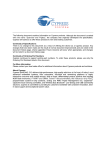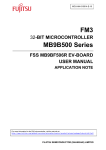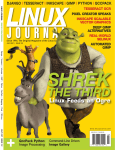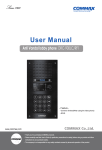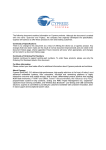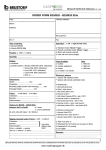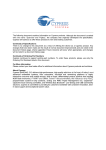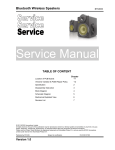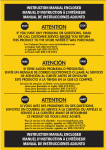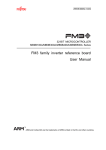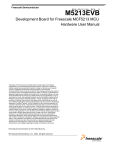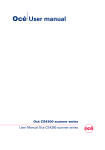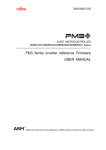Download Simple AV System Board User Manual
Transcript
AN706-00040-2v0-E FM3 Family 32-BIT MICROCONTROLLER FM3 family Application Note Simple AV System Board User Manual ARM and Cortex-M3 are the trademarks of ARM Limited in the EU and other countries. AN706-00040-2v0-E All Rights Reserved. The contents of this document are subject to change without notice. Customers are advised to consult with FUJITSU sales representatives before ordering. The information, such as descriptions of function and application circuit examples, in this document are presented solely for the purpose of reference to show examples of operations and uses of Fujitsu semiconductor device; Fujitsu does not warrant proper operation of the device with respect to use based on such information. When you develop equipment incorporating the device based on such information, you must assume any responsibility arising out of such use of the information. Fujitsu assumes no liability for any damages whatsoever arising out of the use of the information. Any information in this document, including descriptions of function and schematic diagrams, shall not be construed as license of the use or exercise of any intellectual property right, such as patent right or copyright, or any other right of Fujitsu or any third party or does Fujitsu warrant non-infringement of any third-party‟s intellectual property right or other right by using such information. Fujitsu assumes no liability for any infringement of the intellectual property rights or other rights of third parties which would result from the use of information contained herein. The products described in this document are designed, developed and manufactured as contemplated for general use, including without limitation, ordinary industrial use, general office use, personal use, and household use, but are not designed, developed and manufactured as contemplated (1) for use accompanying fatal risks or dangers that, unless extremely high safety is secured, could have a serious effect to the public, and could lead directly to death, personal injury, severe physical damage or other loss (i.e., nuclear reaction control in nuclear facility, aircraft flight control, air traffic control, mass transport control, medical life support system, missile launch control in weapon system), or (2) for use requiring extremely high reliability (i.e., submersible repeater and artificial satellite). Please note that Fujitsu will not be liable against you and/or any third party for any claims or damages arising in connection with above-mentioned uses of the products. Any semiconductor devices have an inherent chance of failure. You must protect against injury, damage or loss from such failures by incorporating safety design measures into your facility and equipment such as redundancy, fire protection, and prevention of over-current levels and other abnormal operating conditions. If any products described in this document represent goods or technologies subject to certain restrictions on export under the Foreign Exchange and Foreign Trade Law of Japan, the prior authorization by Japanese government will be required for export of those products from Japan. The company names and brand names herein are the trademarks or registered trademarks of their respective owners. Copyright© 2011-2012 FUJITSU SEMICONDUCTOR LIMITED all rights reserved 1 AN706-00040-2v0-E Revision History Rev Date Remark 1.0 Aug.23,2011 First Edition 2.0 Feb.06,2012 Correction format Correction lineup of FM3 Correction by RoHS c compliant for board, parts change, and software change 2 AN706-00040-2v0-E Table of Contents Revision History .......................................................................................................................2 Table of Contents .....................................................................................................................3 Target products ........................................................................................................................6 1 INTRODUCTION ..............................................................................................................7 2 OVERVIEW OF SIMPLE AV SYSTEM BOARD ..............................................................7 3 PREPARATIONS ..............................................................................................................8 4 3.1 System Items ............................................................................................................8 3.2 Equipment Other than System Item Required ....................................................... 10 3.3 Board Appearance .................................................................................................. 11 3.4 Power Supply Method ............................................................................................ 12 PROGRAM EXECUTION METHOD ............................................................................. 13 4.1 4.1.1 Activation of KEIL Integrated Development Environment .............................. 13 4.1.2 Start of Sample Program Export and Debug .................................................. 16 4.1.3 Program Execution Using Debugger .............................................................. 18 4.2 5 6 7 Program Execution Using Debugger ..................................................................... 13 Standalone Program Execution ............................................................................. 18 SUPPORTED MEDIA.................................................................................................... 19 5.1 Formats that can be Used for USB Memory.......................................................... 19 5.2 Audio Data ............................................................................................................. 19 5.3 Image Data ............................................................................................................. 20 OPERATION METHOD ................................................................................................. 21 6.1 MP3 File Play ......................................................................................................... 21 6.2 AAC File Play ......................................................................................................... 27 SPECIFICATIONS......................................................................................................... 29 7.1 Hardware................................................................................................................ 29 7.1.1 General Specifications .................................................................................... 29 7.1.2 Hardware Block Diagram ................................................................................ 30 7.1.3 Main Components ........................................................................................... 31 7.1.4 Microcontroller ................................................................................................ 32 7.1.4.1 Pin Connection ........................................................................................ 32 7.1.4.2 Microcontroller Mode Switch and Function Switch ................................. 37 7.1.4.3 USB Interface Function Switching........................................................... 39 7.1.5 DA Converter .................................................................................................. 40 7.1.6 Switches.......................................................................................................... 40 3 AN706-00040-2v0-E 7.1.6.1 Power switch ........................................................................................... 40 7.1.6.2 Key Input Switch ...................................................................................... 41 7.1.6.3 Reset Switch............................................................................................ 41 7.1.7 7.1.7.1 LCD Module with Touch Panel ................................................................ 42 7.1.7.2 Power LED .............................................................................................. 43 7.1.7.3 Selection Indicator LED ........................................................................... 44 7.1.8 7.2 Indicator .......................................................................................................... 42 External Interface............................................................................................ 45 7.1.8.1 Power Supply Interface ........................................................................... 45 7.1.8.2 Audio Interface ........................................................................................ 45 7.1.8.3 USB Interface .......................................................................................... 46 7.1.8.4 JTAG Interface......................................................................................... 47 7.1.8.5 ETM Interface .......................................................................................... 48 Software ................................................................................................................. 49 7.2.1 Software Block Diagram ................................................................................. 49 7.2.2 Software Library.............................................................................................. 50 7.2.3 System Specifications ..................................................................................... 51 7.2.3.1 Microcontroller System Specifications .................................................... 51 7.2.3.2 Memory Map............................................................................................ 52 7.2.3.3 MFS System Specifications..................................................................... 53 7.2.3.4 DMAC System Specifications .................................................................. 53 7.2.3.5 Interrupt System Specifications ............................................................... 54 7.2.4 API Specifications ........................................................................................... 55 7.2.4.1 Audio Playback API ................................................................................. 55 7.2.4.2 Image Display API ................................................................................... 56 7.2.4.3 LED Control API ...................................................................................... 59 7.2.4.4 Switch Detection API ............................................................................... 60 7.2.4.5 Timer Control Driver API.......................................................................... 61 7.2.4.6 Touch Panel Control Driver API ............................................................... 62 7.2.4.7 I2S Driver API........................................................................................... 63 7.2.5 Operation Limit ............................................................................................... 64 7.2.6 Operation Flow of Entire Application .............................................................. 65 7.2.6.1 MP3 ......................................................................................................... 65 7.2.6.2 AAC ......................................................................................................... 69 7.2.7 Application State Transition ............................................................................ 72 7.2.7.1 MP3 ......................................................................................................... 72 4 AN706-00040-2v0-E 7.2.7.2 7.2.8 AAC ......................................................................................................... 78 Operation Flow ............................................................................................... 82 7.2.8.1 Main Processing Function ....................................................................... 82 7.2.8.2 USB Task Processing Function ............................................................... 83 7.2.8.3 File System (MDF) Task Processing Function ........................................ 84 7.2.8.4 HMI Task Processing Function ................................................................ 85 7.2.8.5 AUDIO Play Task Processing Function ................................................... 87 7.2.8.6 Switch Press Detection Processing Function ......................................... 91 7.2.8.7 Processing Function After Switch Press Detection ................................. 92 7.2.8.8 Touch Panel Touch Detection Processing Function ................................ 93 7.2.8.9 Processing After Touch Panel Touch Detection Function ....................... 94 7.2.9 File Configuration............................................................................................ 95 5 AN706-00040-2v0-E Target products This application note is described about below products; (TYPE0) Series Product Number (not included Package suffix) MB9B500B MB9BF504NB,MB9BF505NB,MB9BF506NB MB9BF504RB,MB9BF505RB,MB9BF506RB MB9B300B MB9BF304NB,MB9BF305NB,MB9BF306NB MB9BF304RB,MB9BF305RB,MB9BF306RB 6 AN706-00040-2v0-E 1 INTRODUCTION This user manual contains specifications and information on how to use the simple AV system board. 2 OVERVIEW OF SIMPLE AV SYSTEM BOARD The simple AV system board plays the following 2 types of music media files and performs 1 type of image output. Music media files are however not played simultaneously; The format of played music file is set in accordance with compile options. ① MP3/JPEG JPEG files in a USB memory are imported by the file system, and the data decoded by the JPEG encoder/decoder are output and displayed on the LCD. The MP3 file to be played is selected on the touch panel. It is then imported from the USB memory by the file system, and is played by outputting the data decoded by the MP3 decoder to the DAC. You can select and play MP3 files by switch operation as well. ② AAC The AAC file to be played is selected by switch operation and the AAC file is imported from the USB memory by the file system. The imported AAC file is decoded by AAC decoder and the data is output to the DAC and played. If playing an AAC file, image output to the LCD and touch panel control do not work. Touch TouchPanel PanelControl Control Image ImageOutput Output Image/Audio Image/AudioFile FileRead Read Image/Audio Image/AudioFile FileDecode Decode Switch SwitchDetection Detection Figure 1 System Overview 7 Audio AudioOutput Output AN706-00040-2v0-E 3 PREPARATIONS 3.1 System Items A list of system items of the simple AV system board is given in Table 1, a photograph the external appearance of the AV system board is shown in Figure 2, a photograph the external appearance of ICE is shown in Figure 3, a photograph of the external appearance of the USB memory is shown in Figure 4 and a photograph the external appearance of the USB cable is shown in Figure 5. Table 1 List of System Items No. Name Pcs. Remarks Consists of microcontroller board (KEIL 1 Simple AV System Board 1 MCB9BF500), LCD board and power supply cable 2 2 Pin power connection line 1 2.54mm pitch 3 ICE 1 KEIL ULINK2 4 USB memory 1 BUFFALO RUF-C2GS-BL/U2 5 USB cable 1 ELECOM U2C-B07BK LCD Board Power Supply Cable Microcontroller Board Figure 2 Simple AV System Board 8 AN706-00040-2v0-E Figure 3 ICE Figure 4 USB memory Figure 5 USB cable 9 AN706-00040-2v0-E 3.2 Equipment Other than System Item Required A list of equipment other than system items required is given in Table 2, and equipment used as need is given in Table 3. Table 2 Equipment other than system items required No. 1 Name pcs. PC 1 Specifications / Remarks Use USB host port for power supply. If using ICE, use USB host port. Table 3 List of Equipment Used as Needed No. 1 Name Earphones or speakers pcs. 1 Specifications / Remarks For audio output 10 AN706-00040-2v0-E 3.3 Board Appearance A photograph of the external appearance of the simple AV system board is shown in Figure 6. Figure 6 Photograph of External Appearance of Simple AV System Board 11 AN706-00040-2v0-E 3.4 Power Supply Method USB bus power of the PC is used as the power supply for the simple AV system board. Connect the Type A side of the USB cable (with Type A - Type B connector) to the USB port of the PC and connect the Type B side to the USB power supply connector of the simple AV system board. Press down the power switch with the USB cable connected. The power supply switch is self-locking and stays depressed while the power is on. To turn the power off, press the power switch again. USB Connector for Power Supply Select your favorite music! USB Cable (B Connector Side) Figure 7 USB Cable Insertion Position for Power Supply 12 AN706-00040-2v0-E 4 PROGRAM EXECUTION METHOD 4.1 Program Execution Using Debugger 4.1.1 Activation of KEIL Integrated Development Environment Double-clicking “AV_demo.uvproj” inside the Project folder activates the KEIL integrated development environment and opens the simple AV system project. (1) Designation of Compile Options (MP3 and AAC Switch) Figure 8 Designation Operations of Compile Options As shown in Figure 8, right-clicking on “AV_demo” of the project and then left-clicking “Options for Target „AV_demo‟…” opens the option settings screen. 13 AN706-00040-2v0-E In the case of MP3, set “MUSIC_MP3” for “Define” of the “C/C++” and “Asm” tabs of the option screen; in the case of AAC, set “MUSIC_AAC”. (Figure 9, Figure 10) Setting values -MUSIC_MP3 -MUSIC_AAC Figure 9 C/C++ Compile Options Designation Method Setting values -MUSIC_MP3 -MUSIC_AAC Figure 10 ASM Compile Options Designation Method 14 AN706-00040-2v0-E (2) Program Build プログラムをリビルド Rebuilds program. プログラムをビルド Builds program. Figure 11 Simple AV System Build Click the location shown in Figure 11 to build or rebuild the program. After successfully building or rebuilding, the sample program can be exported to the microcontroller. 15 AN706-00040-2v0-E 4.1.2 Start of Sample Program Export and Debug (1) ICE Connection The equipment connection diagram for exporting the program to the microcontroller is shown in Figure 12. The PC and simple AV system board are connected via ICE. Figure 12 Equipment Connections for Exporting Program (2) Exporting the Program to the Microcontroller Click the location shown in Figure 13 to export the program to the microcontroller. マイコンへプログラムを書き込み Writes program in microcontroller. Figure 13 Exporting the Program to the Microcontroller 16 AN706-00040-2v0-E (3) Debug Activation Click the location shown in Figure 14 and activate the debugger. Debugging can then be started. Starts debug. Figure 14 Operation of Debug Activation 17 AN706-00040-2v0-E 4.1.3 Program Execution Using Debugger When the debugger is activated, the screen appears as shown in Figure 15. Press “Execute” to start executing the program. Execute Figure 15 Screen When Debugger is Activated For other debugger operations, see help. 4.2 Standalone Program Execution When the program is exported and debugging is completed by the procedure given in “4.1 Program Execution Using Debugger,” turn the board's power off with the power switch and remove ICE from the simple AV system board. After doing so, the program is run by standalone by turning the power on with the power switch on the simple AV system board. 18 AN706-00040-2v0-E 5 SUPPORTED MEDIA 5.1 Formats that can be Used for USB Memory The USB memory formats that can be used by the file system are given in Table 4. If using a file system (middleware), a separate contract is required. Table 4 Recognition Media Capacity and Applicable Formats No. Recognition Media Applicable Formats Remarks Capacity 1 Max. 256Mbyte FAT16 / FAT32 2 256M to 8Gbyte FAT32 5.2 Audio Data The items of audio data for the software development environment offered as a sample are given in Table 5. If using MP3/AAC file decoder (middleware), a contract is required. Table 5 Corresponding Audio Data No. Item 1 File format 2 File name 3 Description MP3 and AAC cannot be MP3 or AAC handled simultaneously. (*) “music1.mp3” to “music5.mp3” “music1.aac” to “music5.aac” Sampling 8k/11.025k/12k/16k/22.05k/24k/ rate 32k/44.1k/48k 8k to 320kbps 4 Remarks Unit: Hz VBR not supported Sampling rate is up to Bit rate 160kbps in the case of 44.1kHz/48kHz. [MP3] joint stereo 5 Channel mode Intensity stereo MS stereo dual channel [AAC] stereo(MPEG2/MPEG4) * Cannot be assembled simultaneously due to restriction of microcontroller built-in RAM size. 19 AN706-00040-2v0-E 5.3 Image Data The items of image data supported by the sample program are given in Table 6. If using a JPEG encoder/decoder (middleware), a contract is required. Table 6 Image Data Supported by the Sample Program No. Item 1 File format 2 File name 3 Resolution Description Remarks JPEG “picture1.jpg” to “picture5.jpg” “select.jpg” 240×320 to 3840×5120 [Note] If AAC decoder can be assembled for audio data processing, the JPEG encoder/decoder cannot be assembled due to restriction of the microcontroller built-in RAM size. 20 AN706-00040-2v0-E 6 OPERATION METHOD Touch Operation Area Power Switch Speaker Connector USB Connector for Power Supply Select your favorite music! USB Memory Connector Selection Previous Switch Selection Next Switch Reset Switch Selection Indicator LED Play/Stop Switch Figure 16 Operation Explanation Diagram 6.1 MP3 File Play (1) From Preparation to Power On ① Audio data (music1.mp3 to music5.mp3) and image data (picture1.jpg to picture5.jpg, select.jpg) are contained in the root directory of the USB memory. ② Insert USB memory in USB memory connector of simple AV system board. ③ Connect earphones or speakers to the speaker connector. ④ Connect USB cable to the USB connector for power supply. ⑤ Press down power switch (power on). 21 AN706-00040-2v0-E (2) Song Selection Operation Pressing the song selection next switch selects audio file in the following order. music1.mp3 => music2.mp3 => ... => music5.mp3 If the next switch is pressed while music5.mp3 is selected, music5.mp3 is then selected. Pressing the song selection previous switch selects audio file in the following order. music5.mp3 => music4.mp3 => ... => music1.mp3 If the next switch is pressed while music1.mp3 is selected, music1.mp3 is then selected. LED1 to LED5 correspond to music1.mp3 to music5.mp3; the lit LED indicated the file currently selected. Songs can be selected while music is not played. Select your favorite music! Selection Previous Switch Selection Next Switch Figure 17 Song Selection by Previous/Next Switch 22 AN706-00040-2v0-E (3) Play Start Operation While music is not yet played, the selected music can be played by the following operation. ① Press down the Play/Stop switch. Play/Stop Switch Figure 18 Play Start Operation by Play/Stop Switch ② Touch the thumbnail on the touch panel (LCD) (MP3). (picture1.jpg to picture5.jpg corresponds to music1.mp3 to music5.mp3) Touch the touch operation area image with your finger. Touch Operation Area Select your favorite music! Figure 19 Play Start Operation by Touch Panel The touched image is enlarged and the music linked with the image starts playing. (Example) If the touched image were picture3.jpg, music3.mp3 would be selected. 23 AN706-00040-2v0-E Figure 20 LCD Display While Playing 24 AN706-00040-2v0-E (4) Play Stop Operation While music is playing, it can be stopped by the following operation. ① Press the Play/Stop switch. Play/Stop Switch Figure 21 Play Stop Operation by Play/Stop Switch ② Touch the touch panel. When you touch the enlarged image with your finger, the music stops playing. Touch Operation Area Figure 22 Play Stop Operation by Touch Panel When music is stopped the image simultaneously switches the thumbnail display. 25 AN706-00040-2v0-E Select your favorite music! Figure 23 Thumbnail Display 26 AN706-00040-2v0-E 6.2 AAC File Play (1) From Preparation to Power On Audio data (music1.aac to music5.aac) is contained in the root directory of the USB memory. Insert USB memory in USB memory connector of simple AV system board. Connect earphones or speakers to the speaker connector. Connect USB cable to the USB connector for power supply. Press power switch (power on). (2) Song Selection Operation Pressing the song selection next button selects audio file in the following order. music1.aac => music2.aac => ... => music5.aac If the next switch is pressed while music5.aac is selected, music5.aac is then selected. Pressing the song selection previous switch selects audio file in the following order. music5.aac => music4.aac => ... => music1.aac If the next switch is pressed while music1.aac is selected, music1.aac is then selected. LED1 to LED5 correspond to music1.aac to music5.aac; the lit LED indicated the file currently selected. Songs cannot be selected while music is being played. Stop playing to select. Selection Previous Switch Selection Next Switch Figure 24 Song Selection by Previous/Next Switch 27 AN706-00040-2v0-E (3) Play Start Operation While music is being played, the selected music can be played by the following operation. ・ Press down the Play/Stop switch. Play/Stop Switch Figure 25 Play Start Operation by Play/Stop Switch (4) Play Stop Operation While music is playing, it can be stopped by the following operation. ・ Press the Play/Stop switch. Play/Stop Switch Figure 26 Play Stop Operation by Play/Stop Switch 28 AN706-00040-2v0-E 7 SPECIFICATIONS 7.1 Hardware 7.1.1 General Specifications General specifications of the simple AV system board are given in Table 7. Table 7 General Specifications No. Item Description 1 Microcontroller MB9BF506R(Fujitsu Semiconductor) 2 Power supply USB bus power (+5V) Remarks Does not include 3 Current consumption 300mA(typ.) external connected equipment. 4 5 Switch 6 Key input switch Pushbutton switch x 4 Reset switch Pushbutton switch x 1 USB function Switch Jumper socket x 2 [LCD] 7 LCD panel Indicator with touch panel ・2.4” TFT ・240×320 pixels [Touch panel] ・4-wire resistive touch panel 8 LED 8 units 9 Audio Speaker jack x 1ch 10 11 USB A type×1ch External connection USB I/F I/F For USB memory USB B type×2ch 12 JTAG I/F For KEIL ICE connection x 1ch 13 ETM I/F For KEIL ICE connection x 1ch 14 Environment conditions 0~60 degrees C 15 Dimensions (WxD) 130×135mm(typ.) 16 Weight 164g(typ.) 29 AN706-00040-2v0-E 7.1.2 Hardware Block Diagram The hardware block diagram is shown in Figure 27. LCD Board Speaker Jack MB9BF506R DAC Counter CLK SCK SCK X‟tal CSIO 27MHz Clock Generator OSC Touch Panel Microcontroller Board JTAG JTAG Interface ICE Touch Panel Driver LED Backlight Driver GPIO Switch LCD LCD Driver 5V USB Connector External Bus 5V USB Host LDO USB Host Interface 3.3V LED 3.3V USB host Figure 27 Hardware Block Diagram 30 USB Memory AN706-00040-2v0-E 7.1.3 Main Components A list of main components is given in Figure 8. Figure 8 Main Components of Simple AV System Board No. Part Number pcs. Remarks Fujitsu Semiconductor MB9BF506R 1 Microcontroller 1 2 LCD with touch panel 1 3 LCD Driver 1 ILITEK ILI9320 4 Backlight Driver 1 ROHM BD6067GU 5 Touch Panel Driver 1 MAXIM MXB7843EUE+ 6 Clock Generator 1 IDT MK2705SLF 7 OSC 1 Kyocera CX3225SB27000D0GEJZ1 8 Counter 1 On Semiconductor MC74AC161DG 9 DA converter 1 Audio data conversion, CIRRUS CS4354-CSZ 10 Speaker connector 1 11 USB-B power supply connector 1 Microcontroller Board: KEIL MCB9B500 2.4” TFT AMPIRE AM-240320D4TNQW-00H® For earphones or speakers connection Kycon STX-3500 For supplying power from external USB host (*)Refer to the following URL for the schematics of the microcontroller board. http://www.keil.com/mcb9b500/mcb9bf500-schematics.pdf The above URLs may be changed without notice. 31 AN706-00040-2v0-E 7.1.4 Microcontroller 7.1.4.1 Pin Connection A photograph of the external appearance of the microcontroller is shown in Figure 28 and a list of pin connections is given in Table 9. Microcontroller(MB9BF506R) Figure 28 Photograph of Microcontroller External Appearance Table 9 List of Microcontroller Pin Connections Pin No. Pin Name (Use Connection Destination I/O Function) 01 VCC +3.3V power supply ― 02 MDATA00 LCD controller (D0) I/O 03 MDATA01 LCD controller (D1) I/O 04 MDATA02 LCD controller (D2) I/O 05 MDATA03 LCD controller (D3) I/O 06 MDATA04 LCD controller (D4) I/O 07 MDATA05 LCD controller (D5) I/O 08 SPI_MISO Touch panel controller (DOUT) I 09 SPI_MOSI Touch panel controller (DIN) O 10 SPI_SCK Touch panel controller (DCLK) O 11 (Not used) ― ― 12 (Not used) ― ― 13 (Not used) ― ― 14 MDATA06 LCD controller (D6) I/O 32 Remarks AN706-00040-2v0-E Pin Pin Name (Use No. Connection Destination I/O Function) 15 MDATA07 LCD controller (D7) I/O 16 (Not used) ― ― 17 (Not used) ― ― 18 (Not used) ― ― 19 (Not used) ― ― 20 P36 Touch panel controller (xCS) O INT10_1 Touch panel controller 21 I (xPENIRQ) 22 (Not used) ― ― 23 (Not used) ― ― 24 (Not used) ― ― 25 (Not used) ― ― 26 (Not used) ― ― 27 (Not used) ― ― 28 (Not used) ― ― 29 (Not used) ― ― 30 VSS GND ― 31 VCC +3.3V power supply ― 32 (Not used) ― ― 33 (Not used) ― ― 34 (Not used) ― ― 35 (Not used) ― ― 36 (Not used) ― ― 37 (Not used) ― ― 38 C 4.7 μF capacitor ― 39 VSS GND ― 40 VCC +3.3V power supply ― 41 (Not used) ― ― 42 (Not used) ― ― 43 (Not used) ― ― 44 (Not used) ― ― 45 (Not used) ― ― 33 Remarks AN706-00040-2v0-E Pin No. Pin Name (Use Connection Destination I/O Remarks Function) 46 (Not used) ― ― 47 (Not used) ― ― 48 (Not used) ― ― 49 (Not used) ― ― 50 (Not used) ― ― 51 (Not used) ― ― 52 (Not used) ― ― 53 (Not used) ― ― 54 (Not used) ― ― 55 (Not used) ― ― 56 MD1 GND ― 57 MD0 Jumper pin ― 58 X0 Crystal oscillator (4MHz) I 59 X1 Crystal oscillator (4MHz) I/O 60 VSS GND ― 61 VCC +3.3V power supply ― 62 (Not used) Connected to potentiometer ― 63 (Not used) ― ― 64 P12 65 MAD08 LCD controller (RS) O 66 P14 LCD controller (/RESET) O 67 MCSX0 LCD controller (/CS) O 68 MOEX LCD controller (/RD) O 69 MWEX LCD controller (WR/SCI) O 70 AVCC +3.3V power supply ― 71 AVRH +3.3V power supply ― 72 AVSS GND ― 73 MDATA8 LCD controller (D8) I/O 74 MDATA9 LCD controller (D9) I/O 75 MDATA10 LCD controller (D10) I/O 76 MDATA11 LCD controller (D11) I/O LCD backlight controller (EN) 34 O H/L can be switched LCD backlight control H: Enable, L: Disable L: Reset active AN706-00040-2v0-E Pin No. Pin Name (Use Connection Destination I/O Function) 77 MDATA12 LCD controller (D12) I/O 78 MDATA13 LCD controller (D13) I/O 79 MDATA14 LCD controller (D14) I/O 80 MDATA15 LCD controller (D15) I/O 81 (Not used) ― ― 82 (Not used) ― ― 83 (Not used) ― ― 84 (Not used) ― ― 85 (Not used) ― ― 86 (Not used) ― ― 87 (Not used) ― ― 88 (Not used) ― ― 89 (Not used) ― ― 90 VSS GND ― 91 VCC +3.3V power supply ― 92 TRSTX N.C. ― 93 TCK JTAG connector, ETM connector I 94 TDI JTAG connector, ETM connector I 95 TMS JTAG connector, ETM connector I/O 96 TDO JTAG connector, ETM connector O 97 (Not used) ETM connector I 98 (Not used) ETM connector I 99 (Not used) ETM connector I 100 (Not used) ETM connector I 101 (Not used) ETM connector I 102 (Not used) ― ― 103 SOT4_0 DA converter (LRCK) O DA converter (SCLK/DEM), 104 SCK4_0 Binary Counter I (Q2[8 divisions output]) 105 (Not used) ― ― 106 (Not used) ― ― 35 Remarks AN706-00040-2v0-E Pin No. Pin Name (Use Connection Destination I/O Function) 107 (Not used) ― ― 108 (Not used) ― ― 109 (Not used) ― ― 110 (Not used) ― ― DA converter (SCK), 111 SCK5_1 Binary Counter I (Q2[8 divisions output]) 112 SOT5_1 DA converter (SDIN) O 113 P63 Clock Generator(S0) O 114 (Not used) ― ― 115 P61 Clock Generator(S1) O 116 (Not used) ― ― 117 USBVCC +3.3V power supply ― 118 UDM0 USB jumper pin for selection ― 119 UDP0 USB jumper pin for selection ― 120 VSS GND ― 36 Remarks AN706-00040-2v0-E 7.1.4.2 Microcontroller Mode Switch and Function Switch The microcontroller has the following two modes, which can be switched by external jumper socket. (1) Serial writer mode (2) User mode This section contains an overview of the two modes and a description of the setting method. (1) Serial writer mode [Overview] Built-in flash serial programming of the microcontroller mounted on the microcontroller board can be carried out. For details, see the “Flash Programming Manual” of the microcontroller. [Setting Method] Insert the jumper for switching modes of the microcontroller in the silk notation “MD0H” side. The Operating Mode off the microcontroller is decided after releasing power on reset, low-voltage detection reset and INITX pin input reset. When selecting this mode, set to USB function by switching to USB function function of the microcontroller. Figure 29 Method of Setting Software Writing Mode 37 AN706-00040-2v0-E (2) User Mode [Overview] Mode that activates the internal ROM (flash) of the microcontroller mounted in the microcontroller. Operation starts when the CPU obtains reset vector from the flash memory. Setting the MD0 pin of the microcontroller to “L” level switches to this mode. [Setting Method] Insert the jumper for switching modes of the microcontroller in the silk notation “MD0L” side. The Operating Mode off the microcontroller is decided after releasing power on reset, low-voltage detection reset and INITX pin input reset. When selecting this mode, set to USB function by switching USB host function of the microcontroller. Figure 30 Normal Mode Setting Method 38 AN706-00040-2v0-E 7.1.4.3 USB Interface Function Switching The microcontroller has the following two USB interface functions, which can be switched by external jumper socket. (1) USB Host Interface Function (2) USB Function Interface Function This section contains an overview of the two interface functions and a description of the setting method. (1) USB Host Interface Function (Set when User Mode is Selected) [Overview] The USB interface of the microcontroller is used as the host. [Setting Method] Insert the jumper for switching modes of the microcontroller in the silk notation “HOST” side. Figure 31 USB Host Function Setting Method (2) USB Function Interface Function (Set when Serial Writer Mode is Selected) [Overview] The USB interface of the microcontroller is used as the function. [Setting Method] Insert the jumper for switching modes of the microcontroller in the silk notation “DEV” side. Figure 32 USB Function Function Setting Method 39 AN706-00040-2v0-E 7.1.5 DA Converter The LCD board is equipped with a DA converter for I2S conversion. The external appearance and connection diagram of the DA converter are shown in Figure 33. DA Converter Microcontroller DA Converter Pin No.103:SOT4_0 Pin No.4:LRCK Pin No.104:SCK4_0 Pin No.3:MCLK Pin No.111:SCK5_1 Pin No.112:SOT5_1 Pin No.2:SDIN Pin No.115:P61 Pin No.113:P63 Clock Generator 11.2896MHz or 12.288MHz Pin No.5:SCLK Pin No.5:CLK Pin No.3:S0 Pin No.6:S1 Binary Counter 1.4112MHz or 1.536MHz Pin No.12:Q2 Pin No.2:CP Figure 33 DA Converter External Appearance and Connection Diagram 7.1.6 Switches 7.1.6.1 Power switch The LCD board is equipped with a power switch. The external appearance of the power switch is shown in Figure 34. For power supply method, see section 3.4. Power Switch Figure 34 Power Switch External Appearance 40 AN706-00040-2v0-E 7.1.6.2 Key Input Switch The LCD board is equipped with a power switch. The external appearance and connection diagram of the key input switch are shown in Figure 35. +3.3V Selection Prev Switch Microcontroller Selection Next Switch Selection Prev Switch (P68) Pin No.108:P68 Play/Stop Switch Selection Next Switch (P71) Pin No.52:P71 Pressed Down: L Not Pressed Down: H Play/Stop Switch (P73) Pin No.54:P73 Figure 35 Key Input Switch External Appearance and Connection Diagram 7.1.6.3 Reset Switch The microcontroller board is equipped with a reset switch. The external appearance and connection diagram of the reset switch are shown in Figure 36. +3.3V Microcontroller Reset Switch(Reset) Reset Switch Pin No.43:INITX Pressed Down: L (Reset Active) Not Pressed Down: H Figure 36 Reset Switch External Appearance and Connection Diagram 41 AN706-00040-2v0-E 7.1.7 Indicator 7.1.7.1 LCD Module with Touch Panel The LCD board is equipped with an LCD module with touch panel. The external appearance of the LCD module with touch panel is shown in Figure 37 and the specifications of the LCD module with touch panel are given in Figure 10. For connection of microcontroller and LCD module with touch panel, see Table 9. LCD Module W/Touch Panel Figure 37 External Appearance of LCD Module with Touch Panel Figure 10 Specifications of LCD Module with Touch Panel No. Item Description 1 LCD driver model ILI9320(ILI Technology) 2 Touch panel driver MXB7843EUE+(MAXIM) 3 LCD backlight driver BD6067GU(ROHM) 2.4” TFT 4 LCD with 4-wire resistive touch panel 240×320 pixels 16-bit parallel 42 Remarks AN706-00040-2v0-E 7.1.7.2 Power LED The microcontroller board is equipped with a power LED that indicates power supply status. The external appearance of the power LED is shown in Figure 38 and the specifications are given in Table 11. Power LED Figure 38 Power LED external appearance Table 11 Power LED Specifications No. Item Color 1 Power LED Red Specifications Power ON: On Power OFF: Off 43 Connection Destination +5V power supply AN706-00040-2v0-E 7.1.7.3 Selection Indicator LED The microcontroller board is equipped with a selection indicator LED that indicates selection status. The external appearance and connection diagram of the selection indicator LED are shown in Figure 39 and the selection indicator LED specifications are given in Table 12. +3.3V Microcontroller music5.xxx Pin No.22:P38 Pin No.23:P39 Pin No.24:P3A Selection Indicator LED Pin No.25:P3B Pin No.26:P3C Figure 39 Selection Indicator LED External Appearance and Connection Diagram Table 12 Selection Indicator LED Specifications Microcontroller No. Item Color 1 P38 LED Green Pin No. 22: P38 2 P39 LED Green Pin No. 23: P39 3 P3A LED Green Pin No. 24: P3A 4 P3B LED Green Pin No. 25: P3B 5 P3C LED Green Pin No. 26: P3C connection destination 44 Specifications Microcontroller H output: Off Microcontroller L output: On Microcontroller H output: Off Microcontroller L output: On Microcontroller H output: Off Microcontroller L output: On Microcontroller H output: Off Microcontroller L output: On Microcontroller H output: Off Microcontroller L output: On P3C LED music4.xxx P3B LED music3.xxx P3A LED P38 LED music2.xxx P39 LED music1.xxx AN706-00040-2v0-E 7.1.8 External Interface 7.1.8.1 Power Supply Interface The LCD board is equipped with a USB connector that functions as a power supply interface. Power is supplied by connecting the USB cable to the USB connector for power supply. The external appearance of the USB connector for power supply is shown in Figure 40. The USB connector for power supply uses a conventional USB-B Type connector, but the USB signal line is not connected. Only VBUS and GND are connected. USB Connector for Power Supply Figure 40 USB Connector for Power Supply 7.1.8.2 Audio Interface The LCD board is equipped with a speaker connector that functions as an audio interface. The external appearance and connection diagram of the speaker connector are shown in Figure 41. Speaker Connector DA Converter Pin No.9:AOUTB Pin No.8:AOUTA Audio Connector Figure 41 Speaker Connector External Appearance and Connection Diagram 45 AN706-00040-2v0-E 7.1.8.3 USB Interface The microcontroller board is equipped with a USB memory connector that functions as a USB interface. The external appearance of the USB memory connector is shown in Figure 42 and the USB memory connector specifications are given in Table 13. USB Memory Connector Figure 42 USB Memory Connector External Appearance Table 13 USB Memory Connector Specifications Pin No. Microcontroller connection destination I/O (*) Pin No. 1 ― ― +5V(VBUS) 2 I/O 118 UDM0(D-) 3 I/O 119 UDP0(D+) 4 ― ― GND 5 ― ― GND Signal Name * I/O as seen from the microcontroller. 46 AN706-00040-2v0-E 7.1.8.4 JTAG Interface The microcontroller board is equipped with a JTAG interface connector for software debugging by JTAG interface. The external appearance of the JTAG interface connector is shown in Figure 43 and the pin assignment is given in Table 14. JTAG Interface Connector 10 9 2 1 Figure 43 JTAG Interface Connector External Appearance Table 14 JTAG Interface Connector Pin Assignment Microcontroller I/O connection destination (*) Pin No. Pin No. Signal Name ― +3.3V ― 1 2 ― GND ― 3 ― GND ― ― GND ― GND I/O Microcontroller (*) connection destination Pin No. Signal Name I/O 95 TMS 4 I 93 TCK 5 6 O 96 TDO ― 7 8 I 94 TDI ― 9 10 I 43 RESET * I/O as seen from the microcontroller. 47 AN706-00040-2v0-E 7.1.8.5 ETM Interface The microcontroller board is equipped with an ETM interface connector for software debugging by ETM interface. The external appearance of the ETM interface connector is shown in Figure 44 and the pin assignment is given in Table 15. ETM Interface Connector 20 19 2 1 Figure 44 ETM Interface Connector External Appearance Table 15 ETM Interface Connector Pin Assignment Microcontroller connection I/O destination (*) Pin No. Pin No. Signal Name ― +3.3V ― 1 2 ― GND ― 3 ― GND ― ― GND ― I/O Microcontroller connection (*) destination Pin No. Signal Name I/O 95 TMS 4 I 93 TCK 5 6 O 96 TDO ― 7 8 I 94 TDI GND ― 9 10 I 43 RESET ― GND ― 11 12 O 101 TRACECLK ― GND ― 13 14 O 97 TRACEDATA0 ― GND ― 15 16 O 98 TRACEDATA1 ― GND ― 17 18 O 99 TRACEDATA2 ― GND ― 19 20 O 100 TRACEDATA3 * I/O as seen from the microcontroller. 48 AN706-00040-2v0-E 7.2 Software 7.2.1 Software Block Diagram The software block diagram is shown in Figure 45. Application Application Audio Play Application Switch LED Interface Detection Control MP3/AAC Middleware Decoder Library I2S Control Driver Hardware Image Display JPEG Encoder/ Decoder Library LCD Control Driver Audio Play File System [MDF] USB Host Mass Storage Class (MSC)Driver USB Host Driver Touch Panel Control driver Driver Timer Control Driver Target Board Fujitsu Semiconductor Library Figure 45 Software Block Diagram 49 AN706-00040-2v0-E 7.2.2 Software Library (1) File System Name Multi Device File Access Library V03L01 (object for small MCU, Evaluation) Overview File system library for embedded system (abbreviated as MDF). Used when you want to handle data a directory created by target devices by PC. Facilitates data transfer between PC and devices because multi device data can be managed by the same file and directory format used by the PC. (2) MP3 Decoder Name MP3 Decoder Library for FM3 V01 Evaluation Overview MP3 audio decoder library for embedded system. Decodes MPEG Audio Layer III (MP3) bit stream data and outputs PCM format bit stream data. (3) AAC Decoder Name MPEG-4/2 AAC LC Decoder Library (2ch) for FM3 V01 Evaluation Overview AAC audio decoder library for embedded system. Decodes MPEG-4 and MPEG-2 AAC bit stream data and outputs PCM format bit stream data. (4) JPEG Encoder/Decoder Name JPEG Baseline Process Encoder/Decoder Library for FM3 V01 Evaluation Overview Image encoder/decoder library for embedded system. Encodes and decodes image data based on the baseline process of ITU-T T.8 and ISO/IEC 10918-1 standards, which are the still image compression standards. Decode function only is used for the simple AV system board. 50 AN706-00040-2v0-E 7.2.3 System Specifications 7.2.3.1 Microcontroller System Specifications Microcontroller system specifications are given in Table 16. Table 16 Microcontroller System Specifications Item Description Operation CPU:80MHz Clock APB1 to 3:40MHz ROM(FLASH) 113.0Kbyte (*1) Remarks High-speed PLL oscillation Internal 20 multiplier MP3 Vector section: 248 bytes Program section: 112.7 Kbytes 152.6 Kbytes AAC Vector section: 248 bytes Program section: 152.4 Kbytes RAM (*1) 64.0 Kbytes MP3 Variable: 32.0 Kbytes Stack: 8.0 Kbytes Heap: 24.0 Kbytes 63.8 Kbytes AAC Variable: 24.3 Kbytes Stack: 8.0 Kbytes Heap: 31.5 Kbytes MFS (*2) Uses 2 ch 2 For I S communication With CSIO (*3) as the slave mode, realizes I2S by serial output based on clock input from OSC. For details, see “7.2.3.3 MFS System DMAC System Specifications”. DMAC Uses 4 ch ch. 0/1: For USB host control ch. 2/3: For CSIO data transfer For details, see “7.2.3.4 Specifications”. USB - For USB host control External bus 16bit For LCD control Timer Base Timer ch2 For timer count, 1 ms cycle (*1) For details, see “7.2.3.2 Memory Map”. (*2) Multi Function Serial (MFS) Interface (*3) Clock sync Serial I/O (CSIO) interface 51 AN706-00040-2v0-E 7.2.3.2 Memory Map The memory maps for ROM (flash) and RAM are shown in Figure 46. MP3 ROM(FLASH) 0x0007FFFF AAC RAM ROM(FLASH) 0x20007FFF 0x0007FFFF RAM 0x20007FFF 0x20007FA8 Vacancy Stack 0x20005FA8 Variable Vacancy Variable Vacancy 0x20000000 0x20000000 0x1FFFFFA0 Vacancy Stack 0x1FFFE000 0x0002626C Heap 0x0001C3E8 Program Heap Program 0x1FFF81A0 0x00000100 0x000000F8 0x00000000 Vacancy (GAP) Vector 0x00000100 0x000000F8 0x1FFF8000 0x00000000 Figure 46 Memory Map 52 Vacancy (GAP) Vector Variable 0x1FFF8000 AN706-00040-2v0-E 7.2.3.3 MFS System Specifications MFS system specifications are given in Table 17. Table 17 MFS System Specifications Channel No. Function Baud rate Remarks 0 - - (Not used) 1 - - (Not used) 2 - - (Not used) 3 - - (Not used) 4 2 1411200/1536000 LR channel data output to DAC I S(*) (*) 2 5 I S(*) 1411200/1536000 Audio data output to DAC (*) 6 - - (Not used) 7 - - (Not used) (*) Used as CSIO in slave mode for both channel 4 and 5 Clock uses 8 divisions of 11.2896MHz or 12.288MHz. Because PCM data of 1 sample output to DAC is 16-bit Stereos (2ch), it is played at the sample rate of 44.1kHz or 48kHz by - 141120/ 16(bit) / 2ch =44100 - 1536000 / 16 (bit) / 2 ch = 48000. 7.2.3.4 DMAC System Specifications DMAC system specifications are given in Table 18. Table 18 DMAC System Specifications Channel No. Application Remarks 0 For data transmission to USB 1 For data transmission from USB 2 For I2S (ch5) output data transfer 3 2 For I S (ch4) output data transfer 53 Used for interrupt Set simultaneously with DMAC ch. 2 AN706-00040-2v0-E 7.2.3.5 Interrupt System Specifications Interrupt system specifications are given in Table 19. Table 19 Interrupt System Specifications Interrupt Factor Vector Function Remarks Number Reset Reset_Handler #01 - Base timer ch. 2 BTIM_IRQHandler #47 Processes an interrupt by 1ms interrupt cycle. USB host (each USB_EP0_STA_IRQHandler #50 status) interrupt DMAC ch. Processes an interrupt for USB host interrupt. 2 DMA2_IRQHandler #56 interrupt Processes an interrupt for DMA ch2 interrupt. If there is play data, set transfer of audio data and LR channel data to I2S. 54 AN706-00040-2v0-E 7.2.4 API Specifications This chapter gives I2S driver API used for audio playback processing in addition to API used for application layer. I2S driver API is also described in the application notes for simple AV system solution. For more information, see the notes. 7.2.4.1 Audio Playback API Function void AUDIO_Init(void) Overview Audio playback processing initialization function Invoked before entering the main loop (see “7.2.8.1 Main Processing Function”). Argument None Return None value Function AUDIO_STAGE_ENUM AUDIO_GetAudioStage(void) Overview Audio playback processing status acquisition function Parameter None Return Audio playback processing status value AUDIO_STAGE_INIT After completion of initialization AUDIO_STAGE_OPEN Audio data file open AUDIO_STAGE_LIBRARY_INIT Decoder library initialization AUDIO_STAGE_ANALYZE AUDIO_STAGE_READ Audio data file decode Audio data file read AUDIO_STAGE_DECODING Audio data decode AUDIO_STAGE_UPSAMPLE Decode data up-sampling AUDIO_STAGE_STOP Decode stop Function uint8_t AUDIO_SetAudioStage(AUDIO_STAGE_ENUM Stage) Overview Audio playback processing status setting function Parameter Audio playback processing status The following status setting only for application. AUDIO_STAGE_OPEN Audio data file open AUDIO_STAGE_STOP Decode stop Return Processing results value AUDIO_RET_OK Normal completion AUDIO_RET_INVALID_PARAMETER 55 Parameter error AN706-00040-2v0-E Function void AUDIO_PlayTask(void) Overview Audio play processing main function Invoked during main loop (see “7.2.8.1 Main Processing Function”). Parameter None Return None value 7.2.4.2 Image Display API Function void IMAGE_Init(void) Overview Image display processing initialization function Invoked before entering the main loop (see “7.2.8.1 Main Processing Function”). Parameter None Return None value Function void IMAGE_ClearShow(void) Overview Image display clear function Displays entire LCD in white. Parameter None Return None value 56 AN706-00040-2v0-E Function uint8_t IMAGE_Show( const uint8_t *FileName, uint8_t AreaID, uint16_t Color) Overview Image display control processing function Parameter FileName Filename read from USB memory AreaID LCD display area No. (*) IMAGE_SHOW_AREA1 Area 1 IMAGE_SHOW_AREA2 Area 2 IMAGE_SHOW_AREA3 Area 3 IMAGE_SHOW_AREA4 Area 4 IMAGE_SHOW_AREA5 Area 5 IMAGE_SHOW_AREA6 Area 6 IMAGE_SHOW_AREA7 Area 7 IMAGE_SHOW_AREA8 Area 8 IMAGE_SHOW_AREA9 Area 9 IMAGE_SHOW_AREA_ALL Color All Backgroynd color designation LCD_COLOR_WHITE White LCD_COLOR_BLACK Black LCD_COLOR_GREY Grey LCD_COLOR_BLUE Blue 1 LCD_COLOR_BLUE Blue 2 LCD_COLOR_RED Red LCD_COLOR_MAGENTA Magenta LCD_COLOR_GREEN Green LCD_COLOR_CYAN Cyan LCD_COLOR_YELLOW Yellow Return Processing results value IMAGE_RET_OK Normal completion IMAGE_RET_INVALID_PARAMETER Parameter error IMAGE_RET_ILLEGAL_ERROR Field code failure Memory secure error Designated file does not exist 57 AN706-00040-2v0-E (*) LCD display area corresponds as follows. Area1 Area2 Area3 Area4 Area5 Area6 Area7 Area8 Area9 Figure 47 LCD Display Area 58 AN706-00040-2v0-E 7.2.4.3 LED Control API Function void LED_Init (void) Overview LED control processing initialization function Invoked before entering the main loop (see “7.2.8.1 Main Processing Function”). Parameter None Return None value Function STATUS LED_Set(uint16_t IdCh, uint8_t LEDStatus) Overview LED control processing function Turns specified LED on or off. Parameter IdCh LEDStatus Control target LED (defined by bit) bit0 LED1 bit1 LED2 bit2 LED3 bit3 LED4 bit4 LED5 bit5 LED6 bit6 LED7 bit7 LED8 LED on/off control (corresponding bit=0: off, on when it is 1) Return Processing results value LED_RET_OK bit0 LED1 bit1 LED2 bit2 LED3 bit3 LED4 bit4 LED5 bit5 LED6 bit6 LED7 bit7 LED8 Normal completion LED_RET_INVALID_PARAMETER Parameter error LED_RET_ILLEGAL_ERROR 59 If invoked without being initialized AN706-00040-2v0-E 7.2.4.4 Switch Detection API Function void SW_Init (void) Overview Switch detection processing initialization function Invoked before entering the main loop (see “7.2.8.1 Main Processing Function”). Parameter None Return None value Function STATUS SW_GetStatus(uint8_t ButtonId, uint8_t *pStatus) Overview Switch status acquisition function Parameter ButtonId Switch No. pStatus 0 Play/Stop switch 1 Song selection next switch 2 Song selection previous switch Pointer for place where switch status is stored SW_NO_PUSH Not pressed SW_PUSH Return Processing results value SW_RET_OK Pressed Normal completion SW_RET_INVALID_PARAMETER Parameter error 60 AN706-00040-2v0-E 7.2.4.5 Timer Control Driver API Function void TIMER_Init(void) Overview Initialization function for timer control driver Invoked before entering the main loop (see “7.2.8.1 Main Processing Function”). Parameter None Return None value Function STATUS TIMER_Start(uint8_t IdCh) Overview Timer start function Invoked before entering the main loop and after TIMER_Init invocation (see “7.2.8.1 Main Processing Function”). Parameter IdCh Control target timer ch TIMER_CH2 Base timer ch 2 TIMER_CH3 Base timer ch 3 (*) Ch 3 is not used. Return Processing results value TIMER_RET_OK Normal completion TIMER_RET_INVALID_PARAMETER Parameter error TIMER_RET_ILLEGAL_ERROR Timer control not initialized Designated ch timer operation 61 AN706-00040-2v0-E 7.2.4.6 Touch Panel Control Driver API Function STATUS TOUCH_Init(void) Overview Initialization function for touch panel control driver Invoked before entering the main loop (see “7.2.8.1 Main Processing Function”). Parameter None Return Processing results value TOUCH_RET_OK Normal completion TOUCH_RET_ILLEGAL_ERROR Timer setting failure Function STATUS TOUCH_GetAreaStatus(uint16_t* Status) Overview Touch panel area status acquisition function Parameter Status Pointer to area status acquisition information storage destination If successful, area (see Figure 47) status (touch by 1) is written by bit. bit0 Area 1 bit1 Area 2 bit2 Area 3 bit3 Area 4 bit4 Area 5 bit5 Area 6 bit6 Area 7 bit7 Area 8 bit8 Area 9 Return Processing results value TOUCH_RET_OK Normal completion TOUCH_RET_INVALID_PARAMETER Parameter error 62 AN706-00040-2v0-E 7.2.4.7 I2S Driver API Function void I2S_Init (void) Overview Initializes I2S driver. Sets MFS initial settings (CSIO settings) and DMAC initial settings. Parameter None Return None value Function STATUS I2S_Start (uint8 t audio sample rate) Overview Starts I2S operation. Sets data for DMAC and activates CSIO. Be sure to initialize by I2S_Init function before function is invoked. Parameter Audio sample rate Sampling rate AUDIO_SAMPLE_44100 44.1kHz AUDIO_SAMPLE_48000 48kHz Return I2S_RET_OK Successful value I2S_RET_ILLEGAL_ERROR Function STATUS I2S_Stop (void) Overview Completes I2S operation. Not yet initialized, operating or stopped Stops CSIO. Parameter None Return I2S_RET_OK value I2S_RET_ILLEGAL_ERROR Function uint8_t I2S_Get_Status(void) Overview Acquires I2S operating status. Parameter None Return I2S_STATUS_INIT value I2S_STATUS_START Successful Not yet initialized or stopped Initialization status (I2S can be started) Start (I2S operating) status Stop (I2S cannot be started) status I2S_STATUS_STOP 63 AN706-00040-2v0-E 7.2.5 Operation Limit The following limitations apply to operation of the sample program used by the simple AV system. ◆Concerning assembly of MP3 and AAC decoder The MP3 and AAC decoders cannot conduct processing simultaneously because the built-in RAM size is insufficient. ◆Concerning JPEG file processing for AAC decoder assembly If an AAC decoder is assembled, JPEG file decode processing cannot be conducted because the built-in RAM size is insufficient. 64 AN706-00040-2v0-E 7.2.6 Operation Flow of Entire Application 7.2.6.1 MP3 (1) The application operation flow with audio data playback stopped is as follows. ① USB MSC device connection/disconnection judgment is executed in the main loop. ② If a USB memory is connected, after reading the JPEG files from the USB memory and displaying the images for selection, switch pressing detection and touch panel detection are conducted. ③ If the play/stop switch is detected to be pressed down, or if not detected, but an area of the touch panel is detected to have been touched, the JPEG files corresponding to the selected MP3 file are read from the USB memory and displayed for playback. If the selection previous switch or selection next switch are detected to have been pressed down, MP3 file selection is shifted and LED control is executed. ④ The MP3 selected from the USB memory is then opened. ⑤ The MP3 file header is read, MP3 file header analysis processing is conducted and operation shifts to audio data playback in progress status. This operation is shown in Figure 48. 65 AN706-00040-2v0-E Timer interrupt(ch.2)(1ms) USB-MSC device connection/ disconnection judgement Media files select.jpg picture1.jpg picture2.jpg picture3.jpg picture4.jpg picture5.jpg No Switch detection module Was media connected? Play/Stop switch Yes JPEG File Read all JPEG files and display images for selection on LCD Switch chattering processing Selection previous switch Selection next switch Switch state Switch press detection music1.mp3 No Was the Play/Stop switch pressed? music2.mp3 LED control driver module Yes music3.mp3 LED1 LED2 LED3 LED4 LED5 Read JPEG files corresponding to selected MP3 file numbers and display image for playing on LCD music4.mp3 music5.mp3 Was the Selection previous switch or Selection next switch pressed? Open selected MP3 file Read selected MP3 header data and execute MP3 header analysis processing MP3 header No Yes Change to audio data playback state Select MP3, LED control Touch panel state Touch panel detection No Was touch of touch panel detected? Timer interrupt(ch.2)(1ms) Yes Was the detected area 1-4, or 6? LED state Touch panel control driver module No Area 1 Area 2 Area 3 Yes Select MP3, LED control Read JPEG files corresponding to selected MP3 file numbers and display image for playing on LCD LED state Area 4 Area 5 Area 6 Area 7 Area 8 Area 9 Open selected MP3 file MP3 header Read selected MP3 header data and execute MP3 header analysis processing Change to audio data playback state Figure 48 Application Operation Flow (Audio Playback Stopped Status, Case of MP3) 66 AN706-00040-2v0-E (2) The application operation flow with audio data playback in progress is as follows. ① USB MSC device connection/disconnection judgment is executed in the main loop. ② If the USB memory has been removed, stop playback, close the opened MP3 file, quit the file system and operation shifts to initialization status. ③ If the USB memory is connected, play/stop switch press down detection and touch panel touch detection are executed. ④ If the play/stop switch is detected to have been pressed down, or if not detected, but an area of the touch panel is detected to have been touched, playback is stopped, the MPA file is closed, all JPEF filed are read from the USB memory, that images for selection are displayed and operation shifts to audio data playback stopped status. ⑤ Verify vacancy of input buffer. ⑥ If there is sufficient vacancy, the MP3 file is read from the USB memory and copied in the input buffer. ⑦ One frame of the input buffer is decoded and stored in the RAW buffer. ⑧ When 1 frame had been decoded, the RAW buffer is up-sampled and buried in the output buffer. ⑨ With DMA ch2 interrupt, data is sent from the output buffer to I2S in sequence. This operation is shown in Figure 49. 67 AN706-00040-2v0-E USB-MSC device connection/ disconnection judgement Timer interrupt(ch.2)(1ms) Was media disconnected? Media files select.jpg picture1.jpg picture2.jpg picture3.jpg picture4.jpg picture5.jpg No Switch detection module Yes JPEG file Stop MP3 play Play/Stop switch Close MP3 file Switch chattering processing Selection previous switch Selection next switch End file system music1.mp3 Change to initialization state music2.mp3 music3.mp3 music4.mp3 music5.mp3 Switch state Swith press detection Was the Play/Stop switch pressed? No Timer interrupt(ch.2)(1ms) Yes Touch panel control driver module Stop MP3 play Close MP3 file Area 1 Area 2 Area 3 Read all JPEG files and display images for selection on LCD Area 4 Area 5 Area 6 Change to audio data playback stop state Area 7 Area 8 Area 9 Touch panel state Touch panel detection Was touch of touch panel detected? No Yes No Stop MP3 play Close MP3 file Are there enough empty area in the input buffer? Yes Read all JPEG files and display images for selection on LCD Read MP3 data from media and copy in the input buffer Change to audio data playback stop state One frame of the data in the input buffer is decoded, then store it to the RAW buffer DMA interrupt(ch.2) Sampling data output module PCM data I2S output No Was one frame decoded successful? Output buffer Yes Up-sample the RAW buffer data and copy it to the output buffer PCM data Figure 49 Application Operation Flow (Audio Playback Status, Case of MP3) 68 AN706-00040-2v0-E 7.2.6.2 AAC (1) The application operation flow with audio data playback stopped is as follows. ① USB MSC device connection/disconnection judgment is executed in the main loop. ② If the USB memory is connected, switch press-down detection is executed. ③ If the play/stop switch is detected to have been pressed down, the AAC file selected from the USB memory is opened. If the selection previous switch or selection next switch are detected to have been pressed down, AAC selection is shifted and LED control is executed. ④ The AAC file header is read, AA file header analysis processing is conducted and operation shifts to audio data playback status. This operation is shown in Figure 50. Timer interrupt(ch.2)(1ms) USB-MSC device connection/ disconnection judgement No Switch detection module Play/Stop switch Was media connected? Switch chattering processing Selection previous switch Selection next switch Yes Switch state Switch press detection Media files LED control driver module music2.aac Yes Open selected AAC file music3.aac music4.aac music5.aac No Was the Play/Stop switch pressed? music1.aac AAC header Read selected AAC header data and execute AAC header analysis processing Change to audio data playback state LED1 LED2 LED3 LED4 LED5 Was the Selection previous switch or Selection next switch pressed? No Yes Select AAC, LED control LED state Figure 50 Application Operation Flow (Audio Playback Stopped Status, Case of AAC) 69 AN706-00040-2v0-E (2) The application operation flow with audio data playback in progress is as follows. ① USB MSC device connection/disconnection judgment is executed in the main loop. ② If the USB memory has been removed, stop playback, close the opened AAC file, quit the file system and operation shifts to initialization status. ③ If the USB memory is connected, play/stop button press-down detection is executed. ④ If the play/stop button is detected to have been pressed down, playback stops, the AAC file is closed, and operation shifts to audio data playback stop status. ⑤ Verify vacancy of input buffer. ⑥ If there is sufficient vacancy, the AAC file is read from the USB memory and copied in the input buffer. ⑦ One elementary stream of the input buffer is decoded and stored in the RAW buffer. ⑧ When 1 elementary stream had been decoded, the RAW buffer is up-sampled and buried in the output buffer. ⑨ With DMA ch2 interrupt, data is sent from the output buffer to I2S in sequence. This operation is shown in Figure 51. 70 AN706-00040-2v0-E USB-MSC device connection/ disconnection judgement Timer interrupt(ch.2)(1ms) Was media disconnected? No Switch detection module Yes Stop AAC play Play/Stop switch Close AAC file Switch chattering processing Selection previous switch Selection next switch End file system Change to initialization state Switch state Swith press detection Was the Play/Stop switch pressed? No Yes Stop AAC play No Are there enough empty area in the input buffer? Close MP3 file Yes Media files Change to audio data playback stop state Read AAC data from media and copy in the input buffer music1.aac DMA interrupt(ch.2) Sampling data output module One frame of the data in the input buffer is decoded, then store it to the RAW buffer music2.aac PCM data I2S output music3.aac No Was one frame decoded successful? music4.aac music5.aac Output buffer Yes Up-sample the RAW buffer data and copy it to the output buffer PCM data Figure 51 Application Operation Flow (Audio Playback Status, Case of AAC) 71 AN706-00040-2v0-E 7.2.7 Application State Transition 7.2.7.1 MP3 In the case of MP3, the simple AV system consists of the six states shown in Figure 52. ①Reset state [Initial setting complete] ②Initialization state [Media recognized] [USB memory removed] ③Audio data selection image display processing state [USB memory removed] [USB memory removed] [Image display processing complete] ④Audio data playback stop state [play/stop switch press], [stop by touch panel], or [MP3 file play finish] [Play/stop switch press] or [selection by touch panel] [USB memory removed] [No corresponding MP3 file] ⑤Audio data image display processing state [Image display processing complete] ⑥Audio data playback state Figure 52 State Transition (MP3) ① Reset State The simple AV system is in reset state immediately after the power has been turned on. In the reset state, internal initialization is executed. 72 AN706-00040-2v0-E ② Initialization State When software internal initialization processing is completed and recognition media (USB memory) is inserted, the simple AV system is in initialization state until the media is recognized. [Individual State] Play/stop switch, selection previous switch, selection next switch Does not function even if pressed down. LCD Touch Panel Does not function even if touched. LED All LEDs go off. LCD Total screen displayed in white. USB State where USB connection connector has not been inserted. When a USB memory has been inserted into the USB memory connector, after being recognized, the system shifts to audio data selection image display processing state. 73 AN706-00040-2v0-E ③ Audio Data Selection Image Display Processing State After the USB memory is recognized, the system is in audio data selection image display processing state. Image files are read from the USB memory and images for selecting audio data are displayed on the LCD. After display processing, the system shifts to audio data playback stop state. Track1 Track2 Track4 Track3 Track5 Select your favorite music!! Figure 53 Audio Data Selection Image Display [Individual State] Play/stop switch, selection previous switch, selection next switch Does not function even if pressed down. LCD Touch Panel Does not function even if touched. LED LED1 lights. LCD Image display is as shown in Figure 53. USB State where USB memory is inserted in the USB memory connector. If the USB memory is removed in this state, the system shifts to initialization state and waits for the USB to be re-inserted. 74 AN706-00040-2v0-E ④ Audio Data Playback Stop State After display processing is completed for the LCD in audio data selection image display processing state, the system is in audio data playback stop state. [Individual State] Play/Stop switch With the play/stop switched pressed down, the system shifts to audio data image display processing state. Selection previous switch, selection next switch LED 1 to 5 shift lit. LCD Touch Panel When the audio data images shown in Figure 53 are touched, the system shifts to audio data image display processing state. LED Playback target LED lights. LED 1 lights when USB memory recognition processing is complete. LCD Image display is as shown in Figure 53. USB State where USB memory is inserted in the USB memory connector. If the USB memory is removed in this state, the system shifts to initialization state and waits for the USB to be re-inserted. 75 AN706-00040-2v0-E ⑤ Audio Data Image Display Processing State When the play/stop switch is pressed down in audio data playback stop state or is selection is made from the touch panel, the system is in audio data image display processing state. Image files are read from the USB memory, and audio data images are displayed on the LCD. Figure 54 Audio Data Image Display If the target JPEG file does not exist the entire LCD is displayed in magenta. After display processing is completed for the LCD, if the target MP3 file exists, the system shifts to audio data playback state, If the target MP3 file does not exist, the system shifts to audio data selection image display processing state. [Individual State] Play/stop switch, selection previous switch, selection next switch Does not function even if pressed down. LCD Touch Panel Does not function even if touched. LED Playback target LED lights. LCD Image display is as shown in Figure 54. USB State where USB memory is inserted in the USB memory connector. If the USB memory is removed in this state, the system shifts to initialization state and waits for the USB to be re-inserted. 76 AN706-00040-2v0-E ⑥ Audio Data Playback State After display processing is completed for the LCD in audio data image display processing state, if the target MP3 file exists, the system is in audio data playback stop state. [Individual State] Play/Stop switch Playback is stopped by pressing down the play/stop, and the system shifts to audio data selection image display processing state. Selection previous switch, selection next switch Does not function even if pressed down. LCD Touch Panel If the touch panel is touched, playback stops and the system shifts to audio data selection image display processing state. LED The LED of the target audio data lights. LCD Image display is as shown in Figure 54. USB State where USB memory is inserted in the USB memory connector. If the USB memory is removed in this state, playback stops and the system shifts to initialization state and waits for the USB to be re-inserted. 77 AN706-00040-2v0-E 7.2.7.2 AAC In the case of AAC, the simple AV system consists of the four states shown in Figure 55. ①Reset state [Initial setting complete] ②Initialization state [Media recognized] ③Audio data playback stop state [Play/stop switch press] or [AAC file play finish] [USB memory removed] [USB memory removed] [Play/stop switch press] ④Audio data playback state Figure 55 State Transition (AAC) ① Reset State The simple AV system is in reset state immediately after the power has been turned on. In the reset state, internal initialization is executed. 78 AN706-00040-2v0-E ② Initialization State When software internal initialization processing is completed and recognition media (USB memory) is inserted, the simple AV system is in initialization state until the media is recognized. [Individual State] Play/stop switch, selection previous switch, selection next switch Does not function even if pressed down. LCD Touch Panel Does not function even if touched. LED All LEDs go off. LCD All LEDs go off. USB State where USB connection connector has not been inserted. When a USB memory has been inserted into the USB memory connector, after being recognized, the system shifts to audio data playback stop state. 79 AN706-00040-2v0-E ③ Audio Data Playback Stop State After the USB memory is recognized, the system is in audio data playback stop state. [Individual State] Play/Stop switch With the play/stop switch pressed down, if the target AAC file exists, the system is in audio data playback state. Selection previous switch, selection next switch LED 1 to 5 shift lit. LCD Touch Panel Does not function even if touched. LED Playback target LED lights. LED 1 lights when USB memory recognition processing is complete. LCD All LEDs go off. USB State where USB memory is inserted in the USB memory connector. If the USB memory is removed in this state, the system shifts to initialization state and waits for the USB to be re-inserted. 80 AN706-00040-2v0-E ④ Audio Data Playback State If the play/stop button is pressed down in the audio data playback state, if the target AAC file exists, the system is in audio data playback state. [Individual State] Play/Stop switch Playback is stopped by pressing down the play/stop, and the system shifts to audio data playback stop state. Selection previous switch, selection next switch Does not function even if pressed down. LCD Touch Panel Does not function even if touched. LED The LED of the target audio data lights. LCD All LEDs go off. USB State where USB memory is inserted in the USB memory connector. If the USB memory is removed in this state, playback stops and the system shifts to initialization state and waits for the USB to be re-inserted. 81 AN706-00040-2v0-E 7.2.8 Operation Flow The meanings of the function call points in the flowchart are shown in Figure 56. Function call described in API specifications Function call described in operation flowchart Function call described in API specifications and operation flowchart Figure 56 Meanings of function call points 7.2.8.1 Main Processing Function The flowchart of the main processing function (main) is shown in Figure 57. Start USB host driver initialization (USBH_Initialize) System activation setting (mb9b500_system_boot) MP3 format IMAGE module initialization (IMAGE_Init) Timer module initialization (TIMER_Init) Interrupt enable LED module initialization (LED_Init) while(1) Audio module initialization (AUDIO_Init) USB task processing (av_demoapp_usb_task) Switch module initialization (SW_Init) MDF file system task processing (av_demoapp_MDF_task) Touch panel module initialization (TOUCH_Init) HMI (*) task processing (av_demoapp_HMI_task) Sample application variable initialization (av_demoapp_init) Audio play task processing (AUDIO_PlayTask) Timer ch. 2 activation (TIMER_Start) Figure 57 Main Processing Function Flow (*) Human Machine Interface 82 AN706-00040-2v0-E 7.2.8.2 USB Task Processing Function After detecting USB device connection/disconnection, the processing shown in Figure 58 is executed. (av_demoapp_usb_task) Start USB device connection event occur and disconnection event not occur No USB device disconnection event occur Yes No Yes Clear USB device disconnection event. Clear USB device disconnection event. Set USB disconnection to USB device connected state. Set USB connection to USB device connected state. LED off (LED_Set) USB host driver polling processing (USBH_Polling) Finish Figure 58 USB Task Processing Function Flow 83 AN706-00040-2v0-E 7.2.8.3 File System (MDF) Task Processing Function File System (MDF) processing is executed. (av_demoapp_MDF_task) After reading MBR (*1) and PBR (*2) data, the number of blocks for each sector is calculated. When the MDF file system is initialized, media read and write processing is registered. Start MDF operation stage judgment File open MDF open processing (av_demoapp_MDF_open) File close Initialization Action Others Audio stage initialized? No MDF opened successfully Yes Yes MDF close processing (av_demoapp_MDF_close) Set action stage for MDF stage. Set MDF stage for initialization stage. Light LED 1. Finish Figure 59 File System (MDF) Task Processing Function (*1) Master Boot Record (*2) Partition Boot Record 84 No AN706-00040-2v0-E 7.2.8.4 HMI Task Processing Function HMI processing is executed. (av_demoapp_HMI_task) LCD display, switch detection touch panel detection, etc., user interface processing is executed. Start HMI status judgment Select display Play display MP3 format Display image for playback audio data on entire LCD. (IMAGE_show) MP3 format Display image for audio data selection screen on entire LCD.(IMAGE_show) Set play for HMI status. Display image for selecting each audio data on LCD selection screen.(IMAGE_show) Set open for AUDI stage. Set select display to HMI status. Select Play Switch press detection processing (av_demoapp_sw_detect) Others Processing after switch press detection (av_demoapp_sw_process) MP3 format Touch panel touch detection processing (av_demoapp_tp_detect) Processing after touch panel touch detection (av_demoapp_tp_process) HMI status set to play? No Yes Audio stage initialized? No Yes Set select display to HMI status. 1 Figure 60 HMI Task Processing Function Flow (1) 85 AN706-00040-2v0-E 1 USB device has been removed and HMI status is other than nitialization No Yes MP3 format Clear image for entire LCD. (IMAGE_ClearShow) Set initialization for HMI status. Finish Figure 61 HMI Task Processing Function Flow (2) 86 AN706-00040-2v0-E 7.2.8.5 AUDIO Play Task Processing Function AUDIO Play processing is executed. (AUDIO_PlayTask) Audio data read from the USB memory using the MDF file system is decoded and played. Start Set TRUE for audio play processing loop condition. I2S status stop? No Yes Audio stage is other than stop and other than initialization No Yes Set audio stage to stop. 1 Audio play processing loop condition true? Yes No Finish Figure 62 AUDIO Task Processing Function Flow (1) 87 2 AN706-00040-2v0-E 2 Audio stage judgment Open Open audio file. (audio_decode_open) Audio file opened successfully? No Yes Set library initialization for audio stage. Set initialization for audio stage. 1 Library initialization Initialize decode library. (audio_decode_libraryinit) Decode library successfully initialized? No Yes Set analyze for audio stage. Set stop for audio stage. 1 Analyze File read Decode Sampling Stop Others Analyze audio file header (audio_decode_analyze) Audio file header analyzed successfully? No Yes Set file read for audio stage. 3 Set stop for audio stage. 1 Figure 63 AUDIO Task Processing Function Flow (2) 88 AN706-00040-2v0-E 3 File read Read audio file. (audio_decode_read) Audio file read successfully? No Yes Set decode for audio stage. Set initialization for audio stage. 1 Decode Sampling Stop Others Decode audio file. (audio_decode_decoding) Audio file decode results judgment Successfully decoded Set sampling for AUDIO stage. MP3 format Less than 1 frame Set file read for audio stage. Reset possible error Others (Reset impossible error) Set stop for audio stage. 4 Set library initialization for audio stage. 1 Figure 64 AUDIO Task Processing Function Flow (3) 89 AN706-00040-2v0-E 4 Sampling Sample decode data. (audio_decode_upsample) Sampling results judgment Successfully sampled Output buffer full of sampling data? No Yes Play start flag false? No Yes Is sampling rate 8k,12k,16k,24k,32k,48k? No Yes Start I2S by 48kHz. (I2S_Start) Start I2S by 44.1kHz. (I2S_Start) Set true for play start flag. RAW data buffer has vacancy Set file read for audio stage. Output buffer does not have sufficient vacancy Others Set stop for audio stage. Set false for audio play processing loop condition. 1 Stop Others Stop audio play. (AUDIO_DecodeStop) Set initialization for audio stage. Set false for audio play processing loop condition. Set false for audio play processing loop condition. 1 Figure 65 AUDIO Task Processing Function Flow (4) 90 AN706-00040-2v0-E 7.2.8.6 Switch Press Detection Processing Function Switch press detection processing is executed. (av_demoapp_sw_detect) Play/stop switch, selection next switch, selection previous switch press detection is executed. Start Loop counter <-0 No Loop counter < Number of SW buttons Yes Get switch state. (SW_GetStatus) Yes No current switch press and switch status pressed No No Current switch pressed and switch status not pressed Yes Set not pressed for current switch press status. Set pressed for current switch press status. Set detection for current switch detection status. Increment loop counter. Finish Figure 66 Switch Press Detection Processing Function Flow 91 AN706-00040-2v0-E 7.2.8.7 Processing Function After Switch Press Detection Processing after switch press detection is executed. (av_demoapp_sw_process) Play/stop switch, selection next switch, selection previous switch press detection results are checked and if pressing has been detected, respective switch processing is executed. Start Play/stop switch press detection No Yes Processing after play/stop switch press detection (av_demoapp_sw_play_process) Set no detection for play/stop switch press detection status. Selection next switch press detection No Yes Processing after selection next switch press detection (av_demoapp_sw_next_process) Set no detection for selection next switch press detection status. Selection previous switch press detection No Yes Processing after selection previous switch press detection (av_demoapp_sw_prev_process) Set no detection for selection previous switch press detection status. Finish Figure 67 Processing After Switch Press Detection Function Flow 92 AN706-00040-2v0-E 7.2.8.8 Touch Panel Touch Detection Processing Function Touch panel touch detection processing is executed. (av_demoapp_tp_detect) Detects which position of the nine areas (see Figure 47) on the LCD has been touched. Start Get area status from touch panel. (TOUCH_GetAreaStatus) Loop counter <-0 Loop counter < number of touch areas Yes Current touch panel status changes to touch status No No Yes No Current touch panel status changes to no touch status Yes Set current touch panel touch status to touch detection complete status. Set current touch panel no touch status to touch detection complete status. Set detection for current touch panel detection status. Increment loop counter. Set touch panel area ID Finish Figure 68 Touch Panel Touch Detection Processing Function Flow 93 AN706-00040-2v0-E 7.2.8.9 Processing After Touch Panel Touch Detection Function Processing after touch panel touch detection is executed. (av_demoapp_tp_process) Area state detection results of the touch panel are checked and the processing shown in Figure 69 is executed. Start No Touch panel detection Yes HMI status judgment Select Touch panel area ID 1 to 4, 6? No Yes Touch panel area ID 6? No Yes Set audio file No. to 5. LED display update OK? Set audio file No. to touch panel area ID. No Yes Set audio file No. set as audio file ID. Set play for HMI status. Play Others Set stop for audio status. Release touch panel detection status. Finish Figure 69 Processing After Touch Panel Touch Detection Function Flow 94 AN706-00040-2v0-E 7.2.9 File Configuration The following is a software development environment file configuration provided as a sample. :Common header file directory +---common +---core_cm3.h :Peripheral access definition source file :Middleware directory (*) +---middle :AAC decoder library directory (*) +---aac +---filesystem :File System (MDF) library directory (*) +---jpeg :JPEG decoder library directory (*) +---mp3 :MP3 decoder library directory (*) :Project directory +---project +---AV_demo.uvopt :Option file +---AV_demo.uvproj :Project file +---startup_mb9bf50x.s :Sample source directory +---source +---application :Startup assembler file :Application directory +---hw_support.c :Hardware-dependent processing source file +---hw_support.h :Hardware-dependent processing header file +---av_demoapp.c :Application processing source file +---fs_service.c :File system service source file +---sys_mem.c :System memory processing source file +---sys_timer.c :System timer processing source file +---IRQ.c :Interrupt processing source file +---application_if +---audio +---audio.c :Application interface directory :Audio play processing directory :Audio play processing source file +---upsample.c :Up-sampling control processing source file +---upsample.h :Up-sampling control processing header file +---image +---image.c +---led_sw :Image display processing directory :Image display processing source file :LED control / switch detection processing directory +---led.c :LED control processing source file +---switch.c :Switch detection processing source file 95 AN706-00040-2v0-E :User setting file directory +---config +---usbh_config.c :User setting source file for USB host driver +---audio_config.h :User setting header file for audio play processing +---i2s_config.h :User setting header file for I2S control driver +---led_config.h :User setting header file for LED control processing +---switch_config.h :User setting header file for switch detection processing +---timer_config.h :User setting header file for timer control driver +---touch_config.h :User setting header file for touch panel control driver +---usbh_config.h :User setting header file for USB host driver +---usbh_msc_config.h :User setting header file for USB host mass storage class (MSC) driver +---drivers +---i2s +---i2s.c +---lcd :Driver directory : I2S control driver directory :I2S control driver source file :LCD control driver directory +---lcd.c :LCD control driver source file +---lcd_ili9325.c :ILI9325 control processing source file +---lcd_ili9325.h :ILI9325 control processing header file +---timer +---timer.c +---touch +---touch.c :Timer control driver directory :Timer control driver source file :Touch panel control driver directory :Touch panel control driver source file 96 AN706-00040-2v0-E +---usb :USB host driver directory +---usbh_api.c :USB host driver API source file +---usbh_atch.c :USB connection/disconnection processing source file +---usbh_hc.c :USB host controller processing source file +---usbh_mgr.c :USB host manager processing source file +---usbh_mh_core.c :USB-Mini host controller driver Core processing source file +---usbh_mh_dma.c :USB-Mini host controller driver DMA processing source file +---usbh_mh_hal.c :USB-Mini host controller driver Hardware physical control processing source file +---usbh_req.c :USB host request processing source file +---usbh_api.h :USB host driver API header file +---usbh_atch.h :USB connection/disconnection processing header file +---usbh_hc.h :USB host controller processing header file +---usbh_mgr.h :USB host manager processing header file +---usbh_mh_core.h :USB-Mini host controller driver Core processing header file +---usbh_mh_dma.h :USB-Mini host controller driver Core processing header file +---usbh_mh_hal.h :USB-Mini host controller driver Hardware physical control processing header file +---usbh_req.h :USB host request processing header file +---usb_msc :USB host mass storage class (MSC) driver directory +---usbh_msc_api.c :MSC driver processing API source file +---usbh_msc_bot.c :Bulk Only Transfer processing source file +---usbh_msc_api.c :Manager processing API source file +---usbh_msc_scsi.c :SCSI command processing source file +---usbh_msc_api.h :MSC driver processing API header file +---usbh_msc_bot.h :Bulk Only Transfer processing header file +---usbh_msc_api.h :MSC manager processing API header file +---usbh_msc_scsi.h :SCSI command processing header file 97 AN706-00040-2v0-E :Include file directory +---include +---audio.h :Audio play processing header file +---avdemoapp.h :Application processing header file +---common.h :Common definition header file +---gpio.h :GPIO definition header file +---i2s.h :I2S control driver header file +---cpu :CPU fixed definition header file directory +---image.h :Image display processing header file +---lcd.h :LCD control driver header file +---led.h :LED control processing header file +---switch.h :Switch detection processing header file +---system_dependence.h :System-dependent processing header file +---timer.h :Timer control driver header file +---touch.h :Touch panel control driver header file +---typedef.h :Type definition header file +---usbh.h :USB host driver header file +---usbh_msc.h :USB host mass storage class (MSC) driver header file +---cpu :CPU-dependent header file directory +---cpu_config.h :CPU setting header file +---mb9bf50x :MB9BF500 Series definition header file directory +---cpu_define.h :CPU definition header file +---cpu_define_mb9bf50x.h :MB9BF500 Series CPU definition header file +---cpu_map_mb9bf50x.h :MB9BF500 Series register bit definition header file +---mb9bf50x.h :MB9BF500 Series interrupt vector, register definition header file (*) Only directory provided. Library is provided by separate contract. -End- 98



































































































